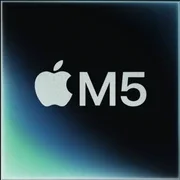Apple M5 10 Cores

Apple Silicon M5: What’s New
At a glance
-
The new baseline M5 chip (third-generation 3-nm) introduces a Neural Accelerator in every GPU core, sharply boosting AI workloads—up to 4× peak GPU compute for AI vs. M4.
-
CPU up to 10 cores (4P + 6E); multithreaded performance uplift is around ~15–20% (device- and workload-dependent).
-
Memory: unified bandwidth 153 GB/s (≈+30% vs. M4), with configurations up to 32 GB in the base lineup.
-
Graphics: third-generation hardware ray tracing; in some MacBook Pro apps, up to 1.6× faster than M4.
-
Launch devices (October 15, 2025): 14″ MacBook Pro, iPad Pro, updated Vision Pro; sales from October 22, 2025.
What it is
M5 is Apple’s new “baseline” Apple Silicon for Macs and iPad. The headline change is a 10-core GPU with a Neural Accelerator in every core, alongside a refreshed CPU and a faster 16-core Neural Engine. That accelerates generative tasks, video upscaling, and on-device inference without relying on the cloud.
Process node. Apple uses a third-generation 3-nm node (industry sources tie this to TSMC N3P), enabling higher clocks and better efficiency without drastic configuration changes.
Architecture and key blocks
-
CPU: up to 10 cores (4 performance + 6 efficiency). Apple highlights “the world’s fastest CPU core”; multithreaded gains are ~15% at the chip level and up to ~20% in typical 14″ MacBook Pro workflows.
-
GPU (10 cores): new gen with a Neural Accelerator per core, RT Gen3, and refined dynamic caching. In AI scenarios the GPU delivers multiples vs. M4; with ray tracing, you’ll see notable gains in FPS and render time.
-
Neural Engine: 16 cores; many AI tasks are now sensibly offloaded to the GPU accelerators—faster and more flexible for larger models.
-
Memory: unified architecture at 153 GB/s, which helps keep larger LLMs and diffusion models on-device; configs up to 32 GB are available.
Performance: what Apple promises
-
AI workloads: peak GPU compute for AI up to 4× vs. M4; on devices (iPad Pro/14″ MBP) AI scenarios can see boosts up to ~3.5×.
-
Graphics: in pro apps and games on the 14″ MacBook Pro—up to 1.6× faster than M4; projects that use RT benefit the most.
-
CPU: about ~15% at the chip level and up to ~20% in real-world tasks (code builds, media pipelines).
Important: these are manufacturer estimates; practical results depend on each device’s thermal envelope, cooling, and how well your software taps into the Neural Accelerators on the GPU.
Devices shipping with M5
-
MacBook Pro 14″ (late 2025): faster graphics (up to 1.6×), multithreaded uplift to ~20%, higher memory bandwidth; starting at $1599, available October 22, 2025.
-
iPad Pro (2025): focus on iPadOS 26’s on-device AI, Wi-Fi 7 across the M5 line, faster memory/storage, and larger RAM options.
-
Apple Vision Pro (2nd gen): moves to M5 for better performance and battery life; comfort improved via accessories.
M5 vs. M4 — in plain words
Compared with M4, M5 keeps a similar maximum CPU layout (up to 10 cores: 4P + 6E) but, thanks to a more advanced 3-nm node and architectural tweaks, delivers a noticeable multithreaded uplift. The major qualitative leap is graphics: M5 adds third-gen ray tracing and a Neural Accelerator in every GPU core, which M4 didn’t have. That yields a multi-fold jump in AI tasks and steady gains in graphics, especially in RT-enabled and generative effects.
Memory bandwidth rises to 153 GB/s on M5 vs. 120 GB/s on M4—about one-third more—benefiting CPU/GPU and ML workloads with large tensors. Both have a 16-core Neural Engine, but M5’s is faster and more tightly integrated with the new GPU path. Overall, M5 is an evolution aimed at on-device AI and graphics, whereas M4 spread its emphasis more evenly across CPU and classic GPU loads without per-core AI accelerators in the GPU.
Positioning and practical takeaways
M5 is a versatile “base” chip for thin devices, now clearly skewed toward local AI workflows. If your day-to-day involves generative graphics, video upscaling/denoise, on-device LLMs, ML-powered photo tooling, or Metal/Neural-API projects, you’ll feel the gains. For pure office work, differences vs. M4/M3 will be moderate.
Important caveats
This is the first wave of M5 devices. Real-world sustained performance depends on the specific model, cooling solution, and app versions. M5 shines the most where software leverages GPU Neural Accelerators and fast unified memory.
Bottom line
Apple Silicon M5 strengthens the base lineup in 2025’s hottest workloads: local AI, advanced graphics, and video. CPU speeds up modestly, but GPU-AI plus 153 GB/s memory bandwidth make M5-based machines meaningfully more capable for creative and ML scenarios—without mandatory cloud dependence.
Basic
CPU Specifications
Memory Specifications
GPU Specifications
Benchmarks
Compared to Other CPU
Share in social media
Or Link To Us
<a href="https://cputronic.com/en/cpu/apple-m5-10-cores" target="_blank">Apple M5 10 Cores</a>